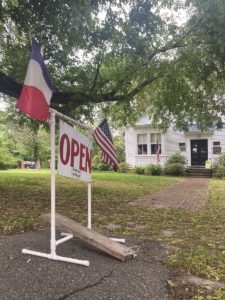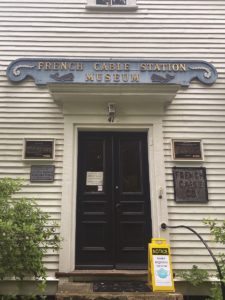ORLEANS — Inside a small white colonial house in Orleans is a telegraph cable station that once made this spot an international communications hub. Now it’s the French Cable Station Museum.
So much depended on an underwater cable with a diameter of only 2.7 inches that extended from Déolen, France to Orleans. It was a cord that carried messages for U.S. military officials during World War I.

In the museum, pieces of the original cable — they look like rusty metal ropes — are on display.
The place is packed with 19th-century artifacts, placed in their original locations, that serve as “a snapshot of 100 years of history,” said Bill Burns, an electrical engineer and technology historian with a passion for the development of electric communications.
During its 70 years of operation, the station’s workers typed up messages that arrived in Morse code. They were using state-of-the-art technology at the time, said Duane Chase, a tour guide and museum board member.
Cape Codders are used to finding pieces of the old cable on beaches and roadsides. That’s because of the system used to repair the cable.
“They would test to see which parts of the cord were still operational using this,” Chase said, pointing to a large transmitter box. “Then, a crew would go out on a boat to bring up the line and cut out the part that was no longer functioning.”
Making repairs was a grueling process, Chase said, because the cable was sometimes as far as two miles under the ocean’s surface. “The repairmen were definitely the highest paid of anyone at the cable station,” said Chase.
The French Cable Station Museum is one of three maintained cable stations in the world that showcase telegraph technology — a predecessor of the internet. The only other remaining stations with authentic technology are the Porthcurno Telegraph Station in the United Kingdom and the Heart’s Content Cable Station in Newfoundland and Labrador.

In the early 1960s, telegraph stations became obsolete. “Not quite overnight, but within a short period of time, all of those telegraph lines were shut down and just abandoned in place,” Burns said. At most cable stations, the equipment was sold for scrap.
The cable station in Orleans proved to be an exception. The station closed in 1959, and in 1972 a group of 10 Orleans residents raised the money to buy it from the French government. “Ten years of barbecues and bake sales,” said Burns. “Those people were really great.”
This same group recruited people with knowledge of the telegraph station to found the museum. “A bunch of the retired operators ended up coming in here and getting all of this stuff to work,” said Chase.
“My dad actually used to work in this very building,” Chase told a group of visitors as they entered the operations room. “I can picture him sitting here with a cup of coffee early in the morning.”
Chase’s father was a telegraph operator here in the 1920s and later became a volunteer guide at the museum. After he retired in 2017, the son followed in his dad’s footsteps.
“I would say that about half of the guides and board members have a family member who worked at the museum when it was a fully functioning cable station,” said Joe Manas, the museum’s president.
It’s a place that reminds us that although our transatlantic cables are now of the fiber optic variety, we are just one degree of separation from Morse code.
This summer, the French Cable Station Museum celebrates its 50th anniversary. The museum is free and open to the public on Fridays, Saturdays, and Sundays from 1 to 4 p.m.
